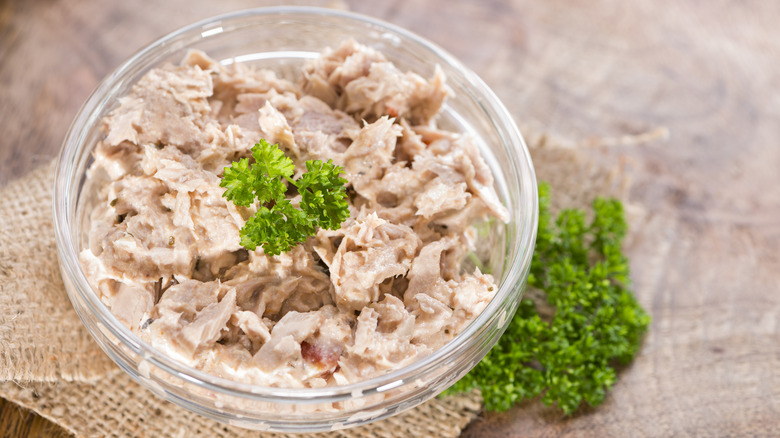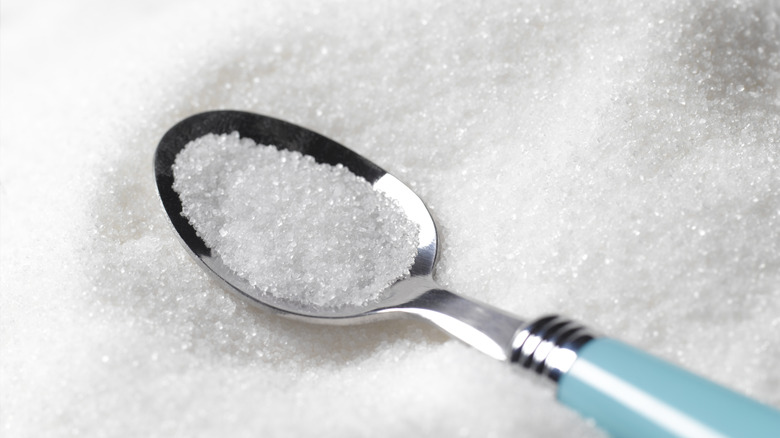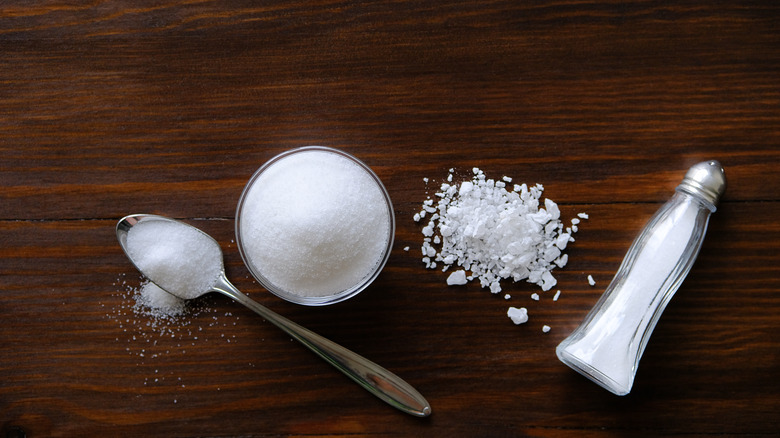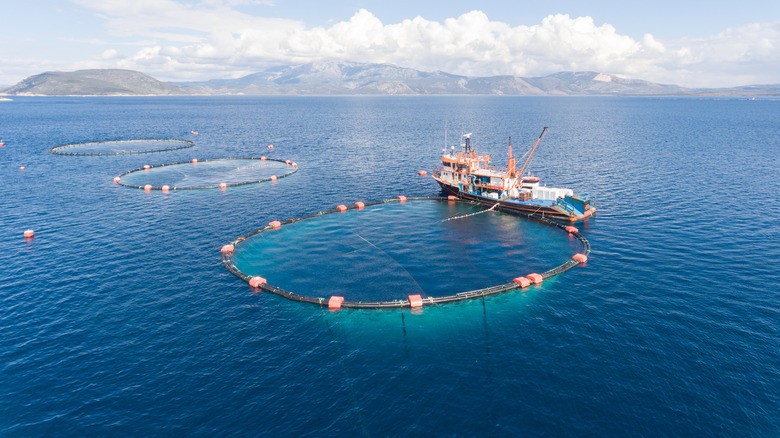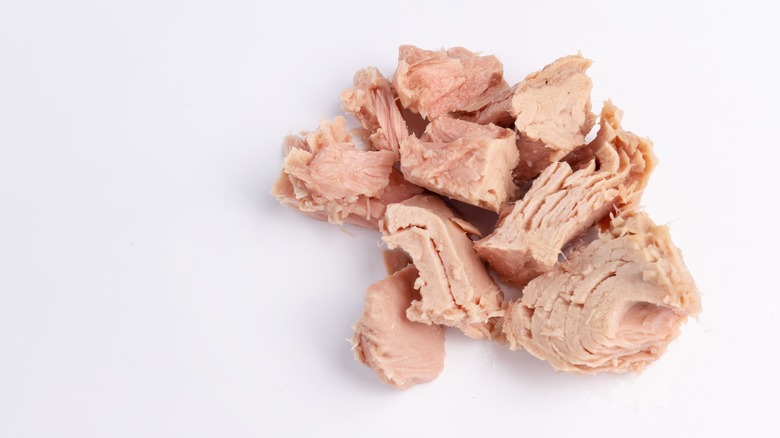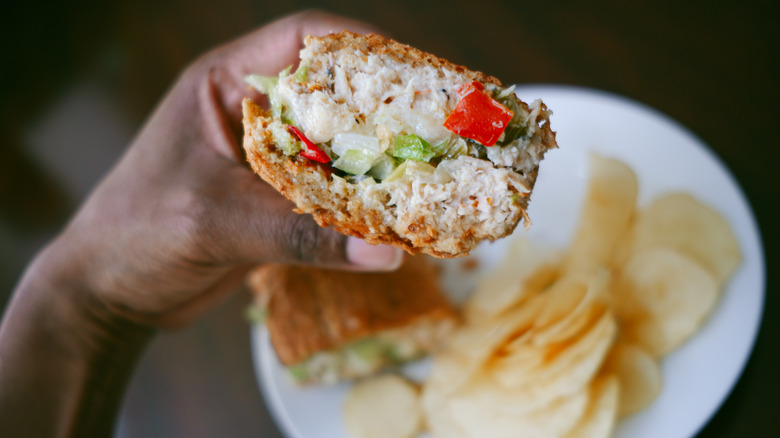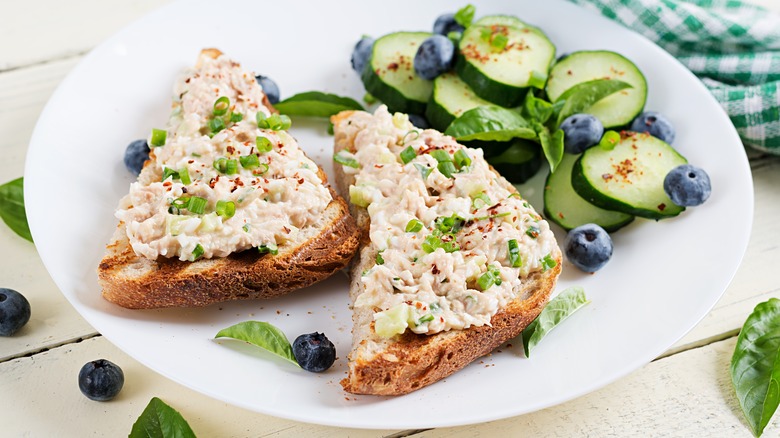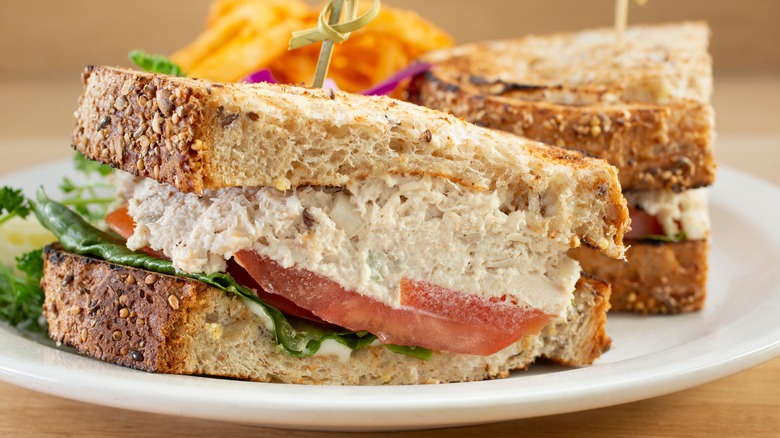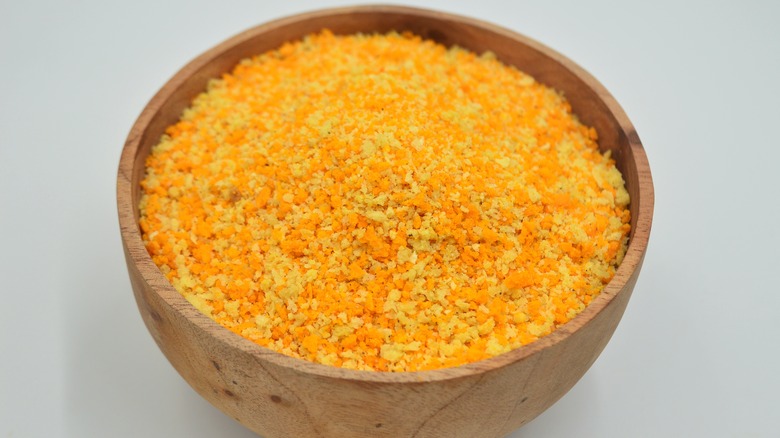8 Red Flags To Look For When Buying Tuna Salad From The Grocery Store
Prepackaged tuna salad is a serious timesaver. When you need a quick lunch with minimal hassle, few things are easier than grabbing some grocery store tuna salad and spreading it on a few slices of bread. However, while homemade tuna salad is generally a pretty simple affair that involves mixing a few different ingredients, grocery store tuna salad can be a little more complicated. These deli items can be full of a lot more items than you might think, and some of the most unhealthy store-bought tuna salads can be riddled with red flags.
While it's not always the case, grocery store tuna salads tend to be pretty high in sodium and saturated fat. Some of them also contain a troubling amount of sugars, which for their recommended serving size can spiral into unhealthy territory. There's no getting around the fact that these food items are, more often than not, pretty highly processed, with concerning extra ingredients coming with the territory. These added ingredients aren't the only red flag, either. Certain store-bought tuna salads can also use tuna that's sourced with unsustainable methods, or which contains worrying amounts of mercury.
1. It has loads of sugars
Good tuna salad nails that balance of sweetness to saltiness, to create a lunch that's a total flavor bomb. However, the sweet part is usually created by a mere pinch of sugar or a little sweet relish. Grocery store tuna salads push things into fairly unpleasant territory, and can often contain an eyebrow-raising amount of added sugars. Kroger's Albacore Tuna Salad, for example, has five grams of added sugar per serving — an amount that's not only high for a savory food, but which covers 20% of the suggested 25 gram daily limit on added sugars for adult women.
Regular high amounts of sugar can have a big impact on your health. There's a direct correlation between added sugar intake and heart disease, potentially thanks to its ability to increase blood pressure and provoke inflammation. Added sugar intake can also make the likelihood of developing diabetes higher, and may promote liver disease. As added sugar can sneak into your diet without you realizing, especially in savory foods like tuna salad, you should always keep an eye on how much your food has. If your tuna salad has more than one or two grams, you should leave it where it is — but in an ideal world, it'll have no added sugars whatsoever.
2. It has a high sodium level
There's no getting around the fact that tuna salad is salty. It kinda comes with the territory, after all, with this dish having a salty-sour flavor profile that the tuna, mayo, and extra ingredients like mustard or pickles add to. However, while tuna salad definitely needs some seasoning, some grocery store tuna salads push things way too far, and cram their products with unnecessary amounts of sodium. One grocery store tuna salad made by Taste of Inspirations has 590 milligrams of sodium per serving, over a quarter of your daily value. That's in just a half-cup of tuna salad, too.
Unfortunately, high sodium levels in processed food items is nothing new. The vast majority of people in the United States eat more than the recommended limit of 2,300 milligrams each day, and most of it comes from processed food items. Virtually everything we eat has some level of sodium in it, because it's in the manufacturer's interests to add it to food, to make it tastier and preserve it for longer. Where you can, you should look for sodium levels that are as low as possible — or just make your own tuna salad at home, with low-sodium ingredients.
3. The tuna in it wasn't sustainably caught
It's always important to make sustainable choices with our food, but with tuna it's especially vital. Tuna fishing is operating at maximum capacity, with some tuna stocks around the world being overfished. If we don't make sustainable choices with our seafood and our tuna, we can contribute to this overfishing. In the worst-case scenario this can lead to stock collapse and endangering tuna populations, as well as endangering other marine wildlife that can be impacted by the fishing process.
As such, looking for tuna salad made with sustainable sources is important. A huge red flag is if the packaging or product information has no information about how the tuna in it was caught. This can indicate that it was caught unsustainably. By contrast, the brands that use sustainable tuna will likely be loudly and proudly displaying their credentials. Look for a blue Marine Stewardship Council (MSC) label on the tuna salad, or check whether it's pole-and-line caught, pole-caught, or troll-caught. Sustainable tuna salads may also have the terms school-caught, free school, or FAD-free on them. If in any doubt, it's far better to buy sustainable cans of tuna, which may be easier to find, and make your own salad.
4. It's not made with skipjack or light tuna
The type of tuna that's in your salad matters. There are several different tuna species, and they all have different mercury levels, with skipjack and light tuna containing the lowest amounts. Albacore tuna, on the other hand, has way more mercury than these other two, and can contain up to three times more mercury than skipjack or light tuna. The reason behind this is quite simple: Albacore tunas are larger and have longer lives, and so they have more capacity to store mercury in their systems.
However, when this albacore is made into tuna salad, all of that mercury comes with it. If you eat significant amounts of tuna salad then this mercury content can add up. In the worst case scenario it can begin to affect your health, causing motor and neurological issues. It's also very risky for children and pregnant people to consume too much mercury, as it can cause developmental issues. The solution here is simple: Try to buy skipjack or light tuna salad wherever possible. Even if you are eating skipjack and light tuna solely, though, you should aim not to eat too much of it regularly, as these kinds can still have notable mercury levels.
5. There's a high amount of saturated fat
Fat gives tuna salad its smoothness, and given that mayonnaise makes up a substantial part of any recipe, it's likely not surprising that it has some saturated fat in it. However, the amount in grocery store tuna salad can be pretty huge. A relatively small amount of grocery store tuna salad can contain a significant amount of your saturated fat daily value — for example, Golden Taste's Tuna Deluxe tuna salad provides a gram of saturated fat per 21-gram serving. Given that most store-bought tuna salads recommend a serving size of about 100 grams, if you add that much to your sandwich, you're getting 5 grams of saturated fat — a quarter of your daily value.
When combined with your other daily meals, this could have you eating way above the recommended limit. Doing so daily can be a real problem. Eating too much saturated fat regularly can raise your cholesterol, which has knock-on effects on your cardiovascular health. We'd therefore recommend steering clear of grocery store tuna salads that have high amounts of this nutrient, and trying to seek out brands that have 2 grams or so per serving (with the serving size being around 100 grams). You can also reduce your saturated fat intake by seeking out low-fat tuna salads, but bear in mind that these may compensate for the lost fatty richness with higher levels of sugar or starch.
6. The tuna salad doesn't have much protein
When made properly, tuna salad is a reliably high-protein dish. The average can of tuna contains around 20 grams of protein, and if there are other high-protein ingredients like eggs or cottage cheese in the recipe, it'll boost its protein content even more. That's why you should always be wary of grocery store tuna salads that are weirdly low in protein. This red flag can indicate that the salad has been bulked out with various ingredients, to make the fish go further and keep costs down.
A lower level of protein may also be accompanied by a higher level of fat or carbohydrates. When you see this, it likely means that the manufacturer has filled their tuna salad with an abundance of mayonnaise, breadcrumbs, or vegetables — and while the extra veggies probably won't be a bad thing, the first two won't do much for you nutritionally. You can reasonably expect around 33 grams of protein per cup of tuna salad, but you'll likely find that most store-bought tuna salads contain a fair bit less.
7. The tuna salad has a lengthy ingredients list
There are loads of unexpected ingredients you can put in tuna salad to make it taste better — but the ingredients that manufacturers put in don't always do the same. If your grocery store tuna salad is plagued with a lengthy list of head-scratching ingredients, it's a sure-fire sign that it's ultra-processed. Tuna salad is a processed food, but there's a big difference between something that's been processed and ultra-processed. Food can be called processed if it's changed in any way, such as if various ingredients have been mixed together. Ultra-processed foods, on the other hand, have been industrially formulated, and contain various additional ingredients like stabilizers, gums, and sweeteners like high fructose corn syrup.
The issue with ultra-processed foods is that eating loads of them can have a real impact on your health. Consuming high levels of these foods has been linked to a higher risk of chronic conditions like type 2 diabetes and cardiovascular disease. When these foods are processed, they can frequently have higher levels of salt, fat, and sugar put into them, depleting their nutritional value. So, as well as looking at the nutritional value of your tuna salad, look at its ingredients list. If it looks unreasonably lengthy or contains loads of items you don't know, it's best to leave it where it is.
8. It's bulked up with breadcrumbs
The beauty of tuna salad is in its texture. Most people think of this dish being mushy, but when it's prepared well, it retains a hint of firmness from its tuna chunks and a pleasing crunchiness from its vegetables. You know what will make your tuna salad mushy, though? Breadcrumbs — and unfortunately, they can be lurking in your grocery store tuna salad.
Manufacturers like Reser's put breadcrumbs in their tuna salad, and we can only assume that they do so to bulk it out and cut costs. Breadcrumbs are way cheaper than tuna, after all. Unfortunately, putting breadcrumbs in means that they soak up the liquids in the tuna salad's creamy dressing, turning soft and gluey and ruining its texture. Plus, breadcrumbs have barely any nutritional value, and so the space in your tuna salad tub is being taken up by an ingredient that won't nourish you. Above everything else, seeing breadcrumbs on a tuna salad ingredient list indicates that the food producer potentially doesn't care about offering a quality product with minimal ingredients. Steer clear of these ones, and pick a tuna salad with as few unnecessary ingredients as possible.
